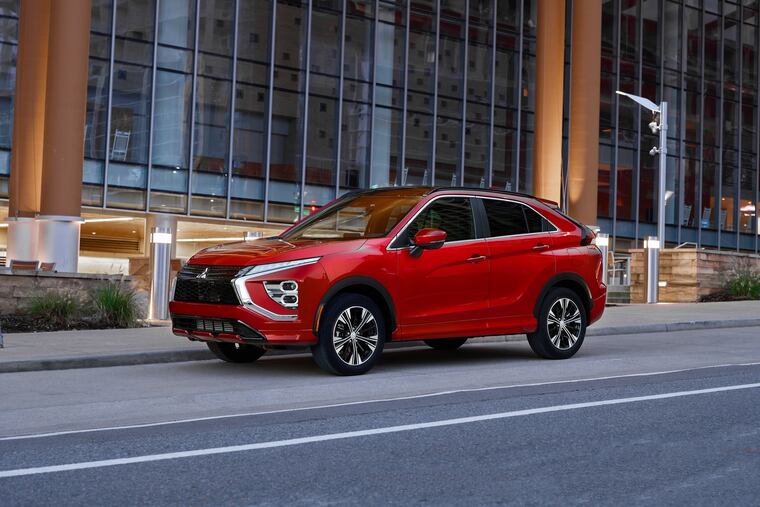2022 Mitsubishi Eclipse Cross vs. 2022 Volkswagen Taos: Baby SUV battle
The all-new miniature SUV from Mitsubishi doesn’t go fast or offer great fun on the curves, but it’s still a leap forward for the automaker.

2022 Mitsubishi Eclipse Cross SEL 1.5T S-AWC vs. 2022 Volkswagen Taos 1.5 SEL: Battle of the off-brand baby SUVs.
This week: Mitsubishi Eclipse Cross.
Price: $34,670 as tested; red paint $595; SEL Touring Package $2,100; SEL Touring Exterior Package $995; and more.
Conventional wisdom: Car and Driver likes the “serene highway cruising, plentiful cargo space, long standard warranty coverage,” but not the “middling acceleration, disappointing fuel efficiency, base model is awfully basic.”
Marketer’s pitch: “Start your engines.”
Reality: A step forward for Mitsubishi.
What’s new: Introduced in 2018, the Eclipse Cross gets a redo for 2022, Mr. Driver’s Seat’s first experience in it. Mitsubishi champions many upgrades, inside and out.
What’s really new: The small SUV shows the great strides Mitsubishi has been making. The last time I had a Mitsubishi — a 2018 Outlander — I actually declined to submit a column. It’s only the second vehicle I ever drove in more than 10 years that I didn’t write about. (The other was a first-gen Nissan Leaf, which had a 65-mile range — except in winter, when it had … 50.)
Back to the Outlander: It fared so poorly in so many categories that I couldn’t bring myself to write it.
And don’t even get me started on the tiny Mirage, which I have written about.
This was my first ride in the Eclipse Cross, and it looks and feels like a Nissan, the company that has had a controlling stake in its former Japanese rival since 2016.
» READ MORE: Audi’s small luxury Q5 SUV is neither plush nor sporty
Up to speed: The 1.5-liter turbo does not feel like a 1.5-liter turbo, but that doesn’t mean it’s a hot rod. Car and Driver reports it’ll arrive at 60 mph in 8.6 seconds, a lethargic pace by modern standards, thanks to the 152 horses under the hood. Its passing acceleration and hill-climbing are also dismal.
Shiftless: The CVT doesn’t make the Eclipse Cross feel too much like a golf cart, which is the most one can hope for. It shifts “gears” through the lever or paddles.
On the road: Handling is competent. The Eclipse Cross goes where you point it on country and suburban roads, although it wanders a lot on the highway. It’s a bouncy time, with a touch of fun when you hit the curves just right.
Soggy ride: Commuting on a busy, wet Schuylkill Expressway, I had my first experience with the adjustable speed limits on that “road.” (My bet for Adjustable Speed Limits 2.0 — adjustable camera-induced fines, sent directly to your mailbox.)
A friendly left-lane bandit tried teaching us all how to drive the speed limit for a few miles, but soon gave up. So I took the opportunity to kick it up a notch when slosh! the Eclipse Cross started to spin out.
The Eclipse Cross features settings for snow, gravel, and mud, but no rain. In hindsight, I should have tried one of the others. Still, if you don’t give drivers a rain setting, it oughta work better in the rain.
Off the road: I did get to try the Eclipse Cross on a gravel country road and found the performance to be impressive. It did much better at 40 on a gravel-covered woodland path than at 50 on a slick Schuylkill Expressway.
Driver’s Seat: The cockpit is much improved over the Outlander. The gauges are mostly easy to read and functions quick to find, though the largest part of the readout tells me whether the vehicle is in Drive or which “gear” it’s in, and the tachometer and speedometer are the same size. I’m really more focused on the speed, especially when I’m driving on the Schuylkill Continuously Variable Expressway, so shouldn’t that be clearer?
But, overall, the components and coverings remind me of a Mazda or a Nissan, so that’s good company.
Friends and stuff: The rear seat has good legroom and great foot room, but only OK headroom — Mr. Driver’s Head reaches the ceiling. The seat is pretty nice, especially for the price range, and the test model rear seat was heated. The middle passenger will face a bit of a hump and a lot of console, but a decent overall seat.
Cargo capacity is 23.4 cubic feet with the rear seat up and 50.1 when it’s folded, but it seriously looks much smaller than that. The rear window comes down at a sharp angle, but at least the split is gone from the previous generation.
» READ MORE: Subaru Forester vs. Mazda CX-5 Carbon: Tortoise vs. hare
Play some tunes: The stereo has come a long, long way, as well, from the unit I’d dubbed “terrible” in my 2018 Outlander notes. Here, the Mitsubishi Power Sound System offers delightful playback that’s very true to the best I get from my songs. Its equalizer settings often need to be adjusted from song type to song type, but it is worth it in the end. I’d call it an A-.
Night shift: The headlights shine where they’re supposed to though the interior lights are a bit strong to see past.
Fuel economy: I averaged about 25 mpg in a more far-reaching round of testing than usual, including a trip in a downpour to Center City, a ride into Delaware, and the usual country road adventures.
Where’s it’s built: Okazaki, Japan.
How it’s built: Consumer Reports says the Eclipse Cross should rate a 3 out of 5 for reliability.
Next week: 2022 Volkswagen Taos 1.5 SEL.